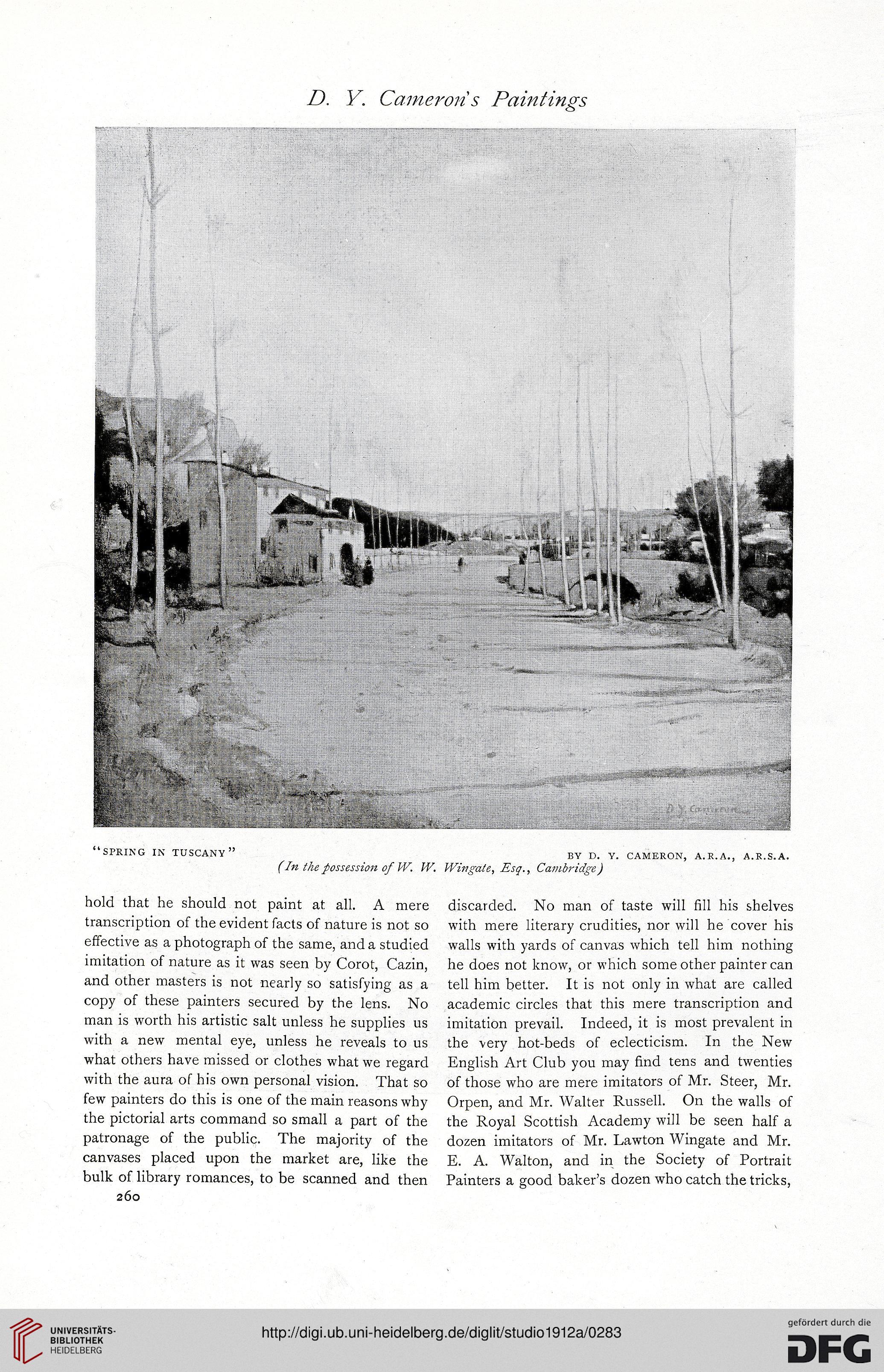D. Y. Cameron s Paintings
“SPRING IN TUSCANY” BY D. V. CAMERON, A.R.A., A.R.S.A.
(In the possession of W. W. Wingate, Esq., Cambridge)
hold that he should not paint at all. A mere
transcription of the evident facts of nature is not so
effective as a photograph of the same, and a studied
imitation of nature as it was seen by Corot, Cazin,
and other masters is not nearly so satisfying as a
copy of these painters secured by the lens. No
man is worth his artistic salt unless he supplies us
with a new mental eye, unless he reveals to us
what others have missed or clothes what we regard
with the aura of his own personal vision. That so
few painters do this is one of the main reasons why
the pictorial arts command so small a part of the
patronage of the public. The majority of the
canvases placed upon the market are, like the
bulk of library romances, to be scanned and then
260
discarded. No man of taste will fill his shelves
with mere literary crudities, nor will he cover his
walls with yards of canvas which tell him nothing
he does not know, or which some other painter can
tell him better. It is not only in what are called
academic circles that this mere transcription and
imitation prevail. Indeed, it is most prevalent in
the very hot-beds of eclecticism. In the New
English Art Club you may find tens and twenties
of those who are mere imitators of Mr. Steer, Mr.
Orpen, and Mr. Walter Russell. On the walls of
the Royal Scottish Academy will be seen half a
dozen imitators of Mr. Lawton Wingate and Mr.
E. A. Walton, and in the Society of Portrait
Painters a good baker’s dozen who catch the tricks,
“SPRING IN TUSCANY” BY D. V. CAMERON, A.R.A., A.R.S.A.
(In the possession of W. W. Wingate, Esq., Cambridge)
hold that he should not paint at all. A mere
transcription of the evident facts of nature is not so
effective as a photograph of the same, and a studied
imitation of nature as it was seen by Corot, Cazin,
and other masters is not nearly so satisfying as a
copy of these painters secured by the lens. No
man is worth his artistic salt unless he supplies us
with a new mental eye, unless he reveals to us
what others have missed or clothes what we regard
with the aura of his own personal vision. That so
few painters do this is one of the main reasons why
the pictorial arts command so small a part of the
patronage of the public. The majority of the
canvases placed upon the market are, like the
bulk of library romances, to be scanned and then
260
discarded. No man of taste will fill his shelves
with mere literary crudities, nor will he cover his
walls with yards of canvas which tell him nothing
he does not know, or which some other painter can
tell him better. It is not only in what are called
academic circles that this mere transcription and
imitation prevail. Indeed, it is most prevalent in
the very hot-beds of eclecticism. In the New
English Art Club you may find tens and twenties
of those who are mere imitators of Mr. Steer, Mr.
Orpen, and Mr. Walter Russell. On the walls of
the Royal Scottish Academy will be seen half a
dozen imitators of Mr. Lawton Wingate and Mr.
E. A. Walton, and in the Society of Portrait
Painters a good baker’s dozen who catch the tricks,




